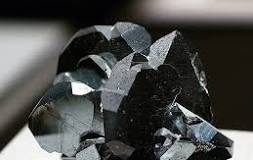
Hematite: Earth’s Metallic Anchor and a Guardian of Grounding Energy
In a world increasingly adrift in digital noise and emotional flux, Hematite stands as an unyielding anchor—offering clarity, focus, and grounding in its most elemental form. Known for its steel-grey lustre and magnetic presence, Hematite has long been revered for both its scientific intrigue and metaphysical strength.
The Geology of Hematite: Metallic Structure and Terrestrial Might
Hematite is an iron oxide mineral (Fe₂O₃), and one of the most abundant minerals on Earth’s surface. It often forms in sedimentary environments or as a result of volcanic activity, typically found in kidney-shaped masses, botryoidal clusters, or tabular crystals.
Its colour ranges from gunmetal grey to deep red—depending on the cut and exposure. Raw Hematite, with its mirror-like shine and high density, is especially striking and is a favourite in mineral specimen jewellery for those seeking a bold, unpolished aesthetic.
Common Locations
Hematite can be sourced from diverse regions, including:
-
Brazil – known for high-grade metallic specimens
-
Morocco – famed for botryoidal forms and radial clusters
-
England – particularly from Cumbria, once a rich iron-mining region
-
United States – especially Michigan, where it was historically significant in iron production
Its shimmering surface and naturally heavy weight have made it a mineral of both industrial and spiritual importance across cultures and centuries.

Energetic Qualities: Grounding, Protection, and Mental Focus
In the realm of crystal healing, Hematite is a root chakra stone, deeply connected to the energy of the Earth. It is widely believed to:
-
Ground scattered energies
-
Enhance focus and logical thinking
-
Protect against negativity and electromagnetic stress
-
Support physical strength and recovery
For empaths or highly sensitive individuals, Hematite is often recommended as a protective shield, helping to block out intrusive energies and maintain emotional sovereignty. Unlike crystals with ethereal or high-frequency properties, Hematite is unapologetically dense and anchoring—a firm hand on your energetic shoulder.
Its mirror-like surface also symbolises reflection: both literal and spiritual. It invites introspection while guarding against overwhelm, making it a favourite among healers, therapists, and mindful practitioners.
The Collector’s Eye: Hematite’s Distinctive Raw Appeal
From a collector’s perspective, Hematite is prized not only for its metallic sheen but also for its unusual formations:
-
Botryoidal clusters – grape-like structures with almost organic curvature
-
Tabular crystals – rare, sharply defined shapes, often with striking striations
-
Specular Hematite – a glittering form flecked with mica-like sparkle
These forms are especially sought-after in crystal specimen rings and handmade gemstone pendants, where the contrast between raw mineral geometry and delicate metalwork creates a bold harmony.
Hematite in History and Lore: A Stone of Warriors and Healers
The legacy of Hematite stretches far beyond its scientific classification. In Ancient Egypt, ground Hematite was used as a pigment for tombs and amulets, believed to offer protection in the afterlife. In ancient Rome, soldiers would wear it before battle, believing it made them invincible and strengthened their blood.
The name “Hematite” derives from the Greek word “haima”, meaning blood—referring to the red streak it leaves when scraped, and hinting at its symbolic connection to vitality and the lifeblood of Earth.
In medieval lore, Hematite was considered a stone of grounding and physical healing. Alchemists and early physicians associated it with the balancing of the four humours, particularly blood. Its dense weight was thought to “pull” ailments from the body back into the earth.
Hematite vs Other Grounding Stones
While many crystals claim grounding properties, Hematite remains distinct in its density and directness:
-
Black Tourmaline is protective, but more deflective than absorptive.
-
Smoky Quartz offers grounding with a gentler, more transparent energy.
-
Obsidian is intense and transformative but often emotionally cathartic.
Hematite, by contrast, is calming, centring, and immediately stabilising. It acts like gravity for the soul, especially when worn close to the root chakra—around the hips, pockets, or as part of a belt or bracelet.
Its electromagnetic affinity also makes it popular in modern settings for counteracting digital overload and EMF pollution.

In Jewellery: The Beauty of Raw and Mineral Specimen Hematite
In contemporary jewellery design, Hematite’s appeal lies in its bold minimalism and earthy authority. Unlike polished or dyed varieties, raw Hematite in mineral specimen form retains its natural texture, sheen, and energetic fullness.
-
Crystal specimen rings often feature sliced or faceted nodules set in fine metal claws, allowing light to dance across its reflective surface.
-
Mineral specimen necklaces offer weight and presence, grounding the heart and spirit.
-
Raw crystal jewellery with Hematite speaks to wearers seeking both style and substance—something tactile, real, and symbolic of their inner resilience.
These pieces are not just ornamental—they’re anchors for intention and energy, crafted to support you in your rituals, your work, and your grounding.
At Oryssia, where every piece is curated with intuitive selection and energetic precision, Hematite is offered not as a mere accessory, but as a tool for presence. One does not choose Hematite lightly—it chooses you when you need to root, focus, or defend your space with grace.